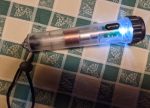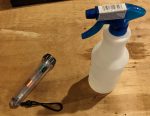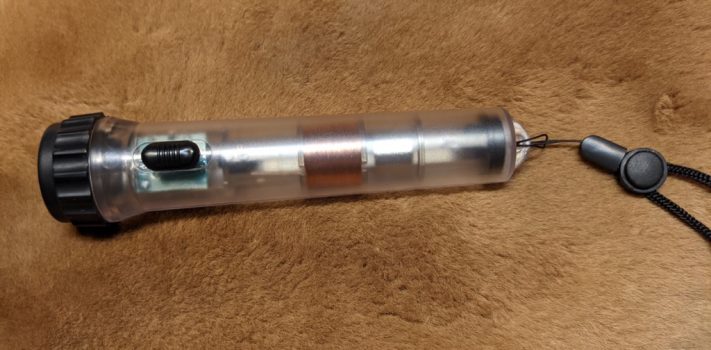The EcoCentricNow Shake Light 40B is a human-powered flashlight. It is fairly reasonably priced, reasonably water resistant, reasonably shock resistant, and reasonably heat resistant. It is charged by a powerful magnet that presents a danger to sensitive equipment, so I do not recommend it for field use or as a children’s toy. I think it could be useful for applications like tornado preparedness kits or as a nightstand flashlight.
The Back Story
I recently submitted an article to SurvivalBlog that included a review of the IKEA Ljusa hand crank flashlight. The beauty of the Ljusa is that the hand crank charges a capacitor rather than a battery. This gives the Ljusa a virtually unlimited shelf life, since it has no batteries to degrade over time. The greatest disadvantage of the Ljusa is that it is no longer in production.
A quick search of the Internet using duckduckgo turned up only one human-powered flashlight that uses a capacitor for storage and is currently in production. It is the EcoCentricNow NightStar Shake Flashlight. With that in mind, I contacted EcoCentricNow to see if they could provide me with a sample of the NightStar Shake Flashlight for testing and evaluation.
Knowing that I write for SurvivalBlog, EcoCentricNow suggested that I test the Shake Light 40B instead. The representative indicated, “The SL40B is a well-constructed, long-lasting, human-powered flashlight, which is price point oriented to emergency preparedness, survival, and outdoor recreation audiences.” Since beggars can’t be choosers, I gratefully agreed. Five days later, a package arrived in the mail.
Opening the Box
The SL40B arrived in a modest box that appeared to be made of recycled paper. The box was somewhat battered in transport, but successfully protected its contents.
The simple instructions were printed directly on the box. These included the following directions. Turn off to charge. Shake moderately. One minute of shaking provides roughly four minutes of light. On a full charge, the SL40B is rated to operate for two hours. Recommended use is 15 to 30 minutes between charges.
The box also contains an important warning. The powerful magnet that charges the light produces a significant magnetic field. It is important to keep the SL40B a safe distance from computers, monitors, televisions, cell phones, gear driven watches, compasses, CRT displays, pacemakers, magnetic tapes, floppy discs, and similar devices. I found out how powerful the magnet is when I tried to measure the length of the flashlight, and the magnet kept sticking to my metal tape measure. The potential danger presented by this powerful magnet means that this flashlight is probably not an appropriate toy for young children, who may inadvertently damage sensitive equipment with it.
The battery in the SL40B is a 40 mA NiMH battery. I am not sure how well this battery will stand up over the course of time. I have had batteries degrade in a number of other human powered appliances over a period of years.
The box also identifies the SL40B as “water resistant.” It does not specify if this is “water resistant” in the IPX1, 2, 3, 4, 5, 6, 7, or 8 sense of the word (dripping, dripping tilted at 15 degrees, spraying, splashing, water jets, powerful water jets, immersion to 1 meter, or continuous immersion to 1 meter, respectively). The light output is rated at 13 lumens.
Upon opening the box, I found the SL40B protected by a layer of bubble wrap. The included lanyard is too small to be of practical use.
I could not find any information on the box or on the light itself regarding its place of manufacture. I had read elsewhere that the light was made is China.
The light measured out at 7 inches long. The barrel of the light tapered from a diameter of approximately 1 1/8 inches at the base, to about 1 ½ inches at the head. The specifications said that the light was white, but it appeared to me to have a slight bluish cast.
The Endurance Test
I began my testing by turning on the light and leaving it on. The light gradually dimmed over the course of the next two hours until it was no longer of any practical use.
I then turned off the light and shook it moderately for about 20 minutes while reading a book.
The Dog Walk Test
 Next, I used the light as I took my dog for his evening walk. An ideal dog walk light is more of a flood than a spot, so that I can see potential obstacles in our path. The beam of the SL40B was too tightly focused for this task. I had to keep moving the light around to scan the area where I was about to walk. So the light did not receive the “Tucker the Beagle Seal of Approval”.
Next, I used the light as I took my dog for his evening walk. An ideal dog walk light is more of a flood than a spot, so that I can see potential obstacles in our path. The beam of the SL40B was too tightly focused for this task. I had to keep moving the light around to scan the area where I was about to walk. So the light did not receive the “Tucker the Beagle Seal of Approval”.
The Night Stand Test
The beam was a little more tightly focused than was ideal for this application, but just slightly so. The fact that I did not have to be concerned about the battery going dead helped to make up for the tightly focused beam. So overall, I would say that this would make a good nightstand light.
The Water Tests
 I took the light out to the barn for some water testing. I suspected that the switch would be the component that would be most susceptible to water, so that is where I focused my testing. First I used a spray bottle to project a fine mist over the switch area. This test produced no noticeable ill effects on the light, which continued to function perfectly.
I took the light out to the barn for some water testing. I suspected that the switch would be the component that would be most susceptible to water, so that is where I focused my testing. First I used a spray bottle to project a fine mist over the switch area. This test produced no noticeable ill effects on the light, which continued to function perfectly.
Next, I set the light on a grating in the bottom of a five gallon bucket, and poured water over it. This also produced no noticeable ill effects.
Then I removed the grating, and added more water to the bucket, until the light was floating. I then weighted the light down to hold it under the water. I could not discern any bubbles coming from the light to indicate that it was leaking.
 After 10 minutes, I removed the light from the water. I noticed small droplets of water on the inside of the transparent case. This would indicate that the light is water resistant in the IPX4 sense of the word. In terms of modes of baptism, it can survive sprinkling and effusion, but not immersion. The light continued to work fine. But if nothing had been done about this water, I would have expected it to gradually corrode the interior components, leading eventually to the failure of the light to operate
After 10 minutes, I removed the light from the water. I noticed small droplets of water on the inside of the transparent case. This would indicate that the light is water resistant in the IPX4 sense of the word. In terms of modes of baptism, it can survive sprinkling and effusion, but not immersion. The light continued to work fine. But if nothing had been done about this water, I would have expected it to gradually corrode the interior components, leading eventually to the failure of the light to operate
The Drop Test
I took the SL40B down in my basement, and dropped it from shoulder height onto the concrete floor several times (er height in my case is about five feet). The third time I dropped the light, the switch popped off. I was able to easily pop the switch back on.
The Heat Test
After seeing the slot that the switch moved in, I was shocked that the light did not take on more water while immersed during the water test. But it also gave me an idea for drying the interior of the light. I removed the switch again, and hung the SL40B next to a warm LED bulb to see if I could encourage the moisture inside the unit to evaporate. Over the course of an hour, this attempt resulted in no significant drying.
Next, I put the light in a 170 degree oven for about an hour. This attempt seemed to make some progress, but still left much moisture behind.
Then I placed the light on the edge of the heat exchanger that brings the water from our outside boiler through our furnace. The water coming from the boiler varies between about 175 and 190 degrees. I left the light on the heat exchanger for several days. The interior of the light became gradually drier, until there were no further signs of moisture after five days. I replaced the switch, and the light operated well. In addition to drying the light, this process demonstrated that the light tolerates heat well.
The History and Science
In October of 1831, Michael Faraday wound wire around a tube of neutral material, and then passed a bar magnet through the tube, creating the world’s first electrical generator. It is this exact same design that provides the electricity that charges the SL40B.
Conclusions
With a manufacturer suggested retail price of $19.95, the Shake Light 40B by EcoCentricNow is a fairly reasonably priced human-powered flashlight. It is also reasonably water-resistant, shock-resistant, and heat-resistant.
Because of the powerful magnet that the light uses for charging, it presents a danger to sensitive equipment like compasses, watches, and GPS units. For this reason, I do not recommend it for field use or as a children’s toy.
I think it could be useful for applications like tornado preparedness kits as long as the kit preparer is careful not to store it next to sensitive equipment. It also makes an adequate nightstand flashlight.
I remain uncertain of the shelf life of the NiMH battery used in the SL40B. As a result, I would recommend that the unit be inspected and tested annually for continued effectiveness.
Disclaimer
EcoCentricNow was kind enough to provide a sample of the SL40B for testing and evaluation. I tried not to let their kindness interfere with the objectivity of my testing. I believe that I have succeeded.










